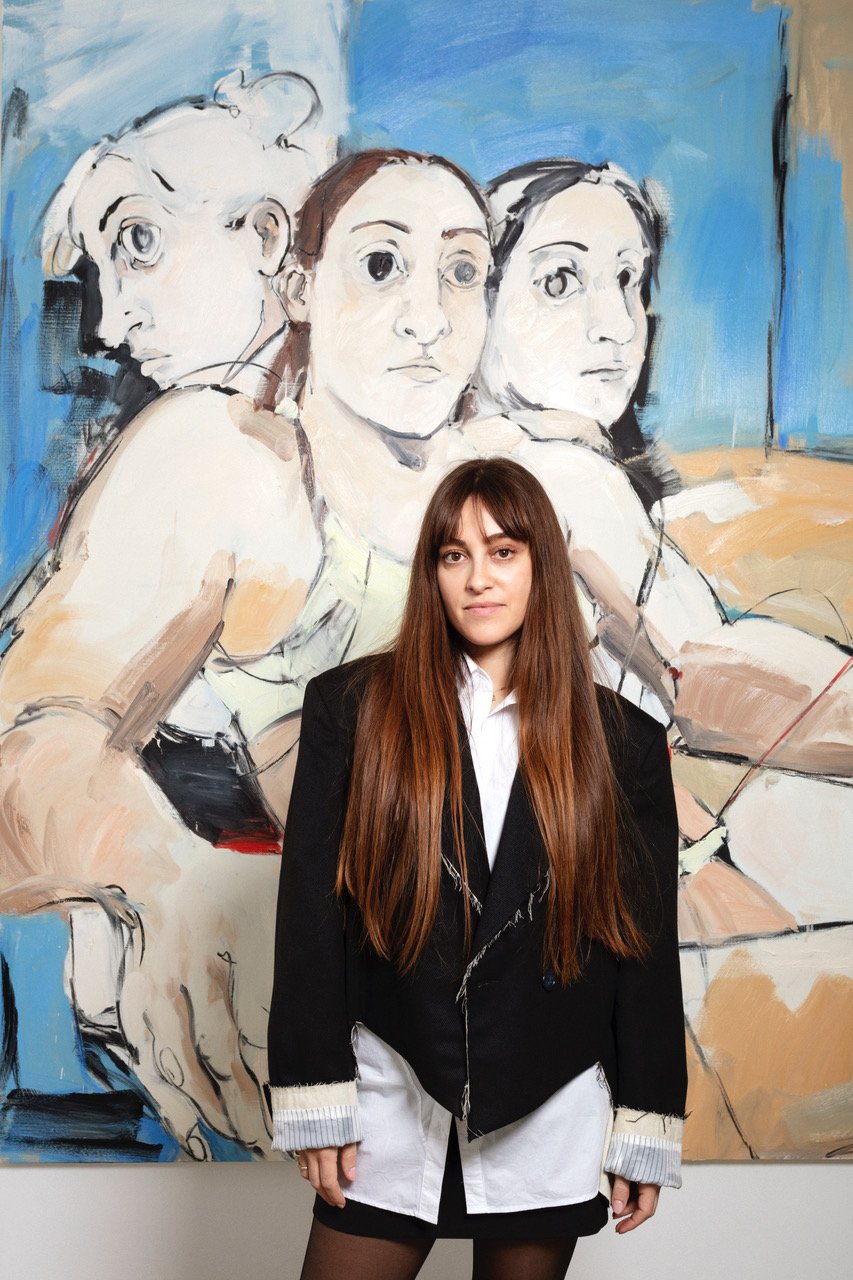
Cristina BanBan stands in front of the rows of painted women that line the walls of her Bushwick studio. “I use female bodies to represent how I’m feeling or what I see around me,” the 34-year-old Spanish artist said on a recent afternoon. “Painting is like keeping a diary—I take my own image as a starting point, and I develop what is most interesting to me.” These layered women are her friends, confidants, and reflections.
BanBan’s bold interpretation of the female form—which she usually depicts in small groups, minimally or undressed, engaging neither with one another nor directly with the viewer—have caught the art world’s attention. Her muscular, brushy forms have been prominently positioned recently at New York fairs, with a monumental canvas on view with Skarstedt at TEFAF’s recent New York edition—which sold for $65,000—and other works at Perrotin’s Frieze New York stand. Both galleries will bring her work to Art Basel in June, and Skarstedt officially began representing her last month.
These days, BanBan’s paintings typically sell for between $30,000 to $95,000, while her drawings fetch between $8,000 and $21,000—nearly triple what they sold for just a few short years ago. Curators are taking notice, too: She was included in the group show “This is America” at Hamburger Kunsthalle last year, and her work has been acquired by the Columbus Museum of Art in Ohio and the Institute of Contemporary Art, Miami.
Cristina BanBan, Self Portrait (2022). Photo by Claire Dorn, courtesy of the artist and Perrotin.
“Cristina isn’t afraid to paint monumentally and with muscle,” said gallerist Emmanuel Perrotin, who had followed the artist’s work from afar for several years before gallery director Valentine Blondel urged him to visit her studio.
“The moment I walked into Cristina’s studio, I knew that we stumbled upon something special,” he said. “After speaking with Cristina, even for a moment, it becomes clear that the painter is the painting—each one is assertive and rhythmic, but like Cristina, it moves quickly, and there’s a feeling that you must keep up. The painting moves on when it’s ready, not when you are.” Her show at Perrotin Paris, on view through the end of the month, has received strong interest from European collectors.
Her work is beginning to draw big prices at auction, too. In March, El Sueño Va Sobre El Tiempo (2019), a rollicking portrait of three bulbous female figures tangled around each other, fetched a record £138,600 at Phillips London, almost seven times its £20,000 high estimate. This follows the sale of her luscious 2018 painting of a man and woman in the bath, which fetched £60,480 at Phillips’s New Now sale in December, shattering its £10,000-to-£15,000 estimate.
BanBan is creating around 15 new works for her debut solo show with Skarstedt in New York this fall. “Cristina’s unique understanding of the female body reacts to and complements the practice of many of the artists that we work with,” Per Skarstedt said.
BanBan began developing her interest in painting the human form as a child in Barcelona. “At the age of five, I started attending an art program after school,” she said. Every day for roughly the next 12 years, she showed up for class at 5 p.m. “I studied everything about art there; I learned how to draw from a live model, how to mix colors, and color theory from a very young age.”
By the time she was a teenager, she was teaching young children at the very same program. She ultimately earned her BFA at the University of Barcelona. Looking for a fresh start, she moved to London in 2012, where she learned English and began to focus on painting.
“I learned [my style of] painting by making errors, and by working a lot,” she said. “The only thing I kept doing throughout the years was painting female bodies.” A few years later, she was ready for New York, and moved a few months before global lockdowns began.
Cristina BanBan, Les Senyoretes (2021). Photo by Claire Dorn, courtesy of the artist and Perrotin.
BanBan has made her women wilder and more confident with each pass. “I start by drawing two or three figures at a time, [adding to them] until I’m happy with the composition,” she explained. “Then I add charcoal, and then, after that, I start painting. I build up every character and then I add color later.”
Her classic subjects are nude but for a bit of lingerie or a hair clip. “I’m interested in the body; I’m not interested in painting clothing,” Banban said. “But I put a little bit of color in the underwear so the characters can look contemporary. It’s a way of keeping a little bit of personality in.” Characteristics move around the canvas fluidly, and sometimes traits from one woman’s body end up on another’s; their eyes or hands grow with expression and nervous excitement, even if the rest of their bodies remain proportional.
BanBan’s work can evoke the worlds of other painters—Cecily Brown’s restless, carnal vibrance; Lucian Freud’s arresting, thick-skinned figures; Francis Bacon’s hallucinating loners. As her artistic heroes, she cites Willem de Kooning, particularly the chapter in his career in which his style straddled between figuration and abstraction, and Paula Rego, whose work is rooted in feminism and folklore. But by and large, she tries to keep the noise of influence out. “I try not to look at [the work of] other painters,” Banban said. “I just try to fill my mind with great conversations with friends.”
BanBan can maintain these conversations and intimacies on the canvases that sit on the bright white walls and floor of her studio. “At this moment,” she said simply, “I’m thinking about what is exciting me about painting.”